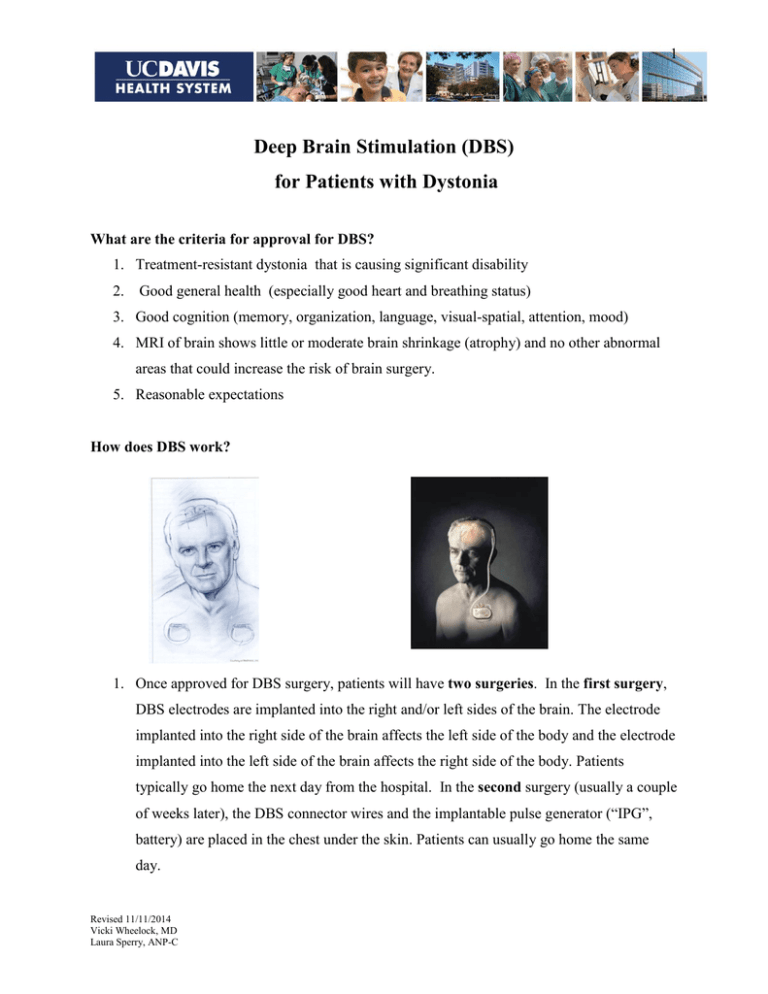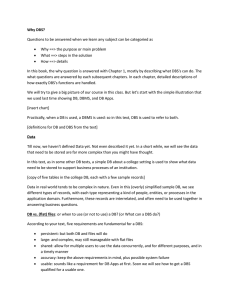Deep Brain Stimulation (DBS) for Patients with Dystonia
advertisement

1 Deep Brain Stimulation (DBS) for Patients with Dystonia What are the criteria for approval for DBS? 1. Treatment-resistant dystonia that is causing significant disability 2. Good general health (especially good heart and breathing status) 3. Good cognition (memory, organization, language, visual-spatial, attention, mood) 4. MRI of brain shows little or moderate brain shrinkage (atrophy) and no other abnormal areas that could increase the risk of brain surgery. 5. Reasonable expectations How does DBS work? 1. Once approved for DBS surgery, patients will have two surgeries. In the first surgery, DBS electrodes are implanted into the right and/or left sides of the brain. The electrode implanted into the right side of the brain affects the left side of the body and the electrode implanted into the left side of the brain affects the right side of the body. Patients typically go home the next day from the hospital. In the second surgery (usually a couple of weeks later), the DBS connector wires and the implantable pulse generator (“IPG”, battery) are placed in the chest under the skin. Patients can usually go home the same day. Revised 11/11/2014 Vicki Wheelock, MD Laura Sperry, ANP-C 2 2. The newest models provide advanced programming features that allow for fine tuning and customized therapy. The Activa PC is a dualchannel device that can control both electrodes. The Activa RC is also a dual-channel device but has a rechargeable battery. The Activa SC is a single-channel device that controls one DBS electrode. Patients with the Activa SC needing two electrodes will need to have an IPG implanted on each side of the chest. The older Soletra and Kinetra models have been discontinued. 3. About a month after your electrodes are implanted, we program the DBS using a handheld computer. Once activated, the DBS electrode delivers small amounts of electrical current into the target brain area. You will also be given a home programmer that allows you to adjust your deep brain stimulation, if needed. 4. The electrical current blocks or changes the firing pattern of nerve cells to improve dystonia symptoms. What is the difference between STN and GPi? Traditionally, patients with dystonia have been treated with DBS of the globus pallidus internus (GPi) but the subthalamic nucleus (STN) is also a potential target for some dystonia subtypes. Your surgical team will decide which implantation site is best for you. Revised 11/11/2014 Vicki Wheelock, MD Laura Sperry, ANP-C 3 What are the benefits of DBS? 1. DBS has been FDA approved under a Humanitarian Device Exemption. 2. DBS is adjustable which means that stimulation parameters can be personalized to fit your needs 3. DBS does not cure dystonia. 4. There are a wide range of outcomes depending upon the type of dystonia a. Childhood/juvenile-onset primary generalized dystonia have the best outcome with a 50-70% improvement on a standard dystonia scale b. Adult-onset cranial/cervical and tardive dystonia may show a 35-80% improvement c. Secondary dystonia shows a less robust response with only 1-2-% improvement on dystonia rating scales Can some symptoms get worse with DBS? 1. Speech is usually a little or even moderately worse after bilateral DBS. The reason is not clear, but it is due to DBS. The voice may be considerably softer, and speech may be somewhat slurred or even stuttering. 2. Some patients seem to fall more after bilateral DBS. This may be due to excessive relaxation of muscles that were very tense before surgery. Some patients will need to use a walker to prevent falls after surgery. 3. A delayed side effect may be difficulty opening the eyes or keeping them open. We have seen this in very few patients, but in France up to 30% of patients developed this symptom. It can be improved by adjusting PD medication or DBS parameters, and sometimes we recommend small injections of Botox into the muscles near the eyes. What are the risks of DBS? 1. The most serious risk is of stroke from bleeding in the brain or loss of blood flow to the brain. This can rarely cause death or permanent brain damage (impaired speech, Revised 11/11/2014 Vicki Wheelock, MD Laura Sperry, ANP-C 4 thinking, or vision; numbness, paralysis, or any neurological deficits). In centers where many DBS procedures are performed, this risk is usually less than 2%. 2. The second most serious risk is of heart, breathing or other medical problems that occur during or after surgery as a result of the stress of surgery. Rarely, this can result in heart attack, blood clots to the lungs, pneumonia, air emboli or other serious and potentially fatal conditions. The risk of these complications is also very low (<2%). We require medical clearance from your physician prior to surgery. 3. Some patients may have a seizure during or after DBS surgery. The cause is irritation of surface brain cells. We prescribe medicine to prevent further seizures for about 6 months. This may occur in about 3-5% of patients. 4. Infection is a more common risk because DBS requires placing foreign objects in the body. Even a single germ that enters the wound can cause an infection. Some chronic infections appear years after surgery as an “erosion” or opening of the skin over the DBS wire, connector or IPG. Infections may be very serious and often result in the need to surgically remove all or part of the DBS system. Patients may be treated with IV antibiotics for 6 weeks. The DBS component can then be re-implanted in most cases. The risk of serious infection is at least 5%. We take meticulous care to reduce the risk of infection, but, with an implantable device, infections cannot be completely avoided. 5. Patients who are older (usually over 65) or who have some reduced thinking abilities can become confused or hallucinate during or after DBS surgery. This symptom can last 1-7 days and requires a longer hospital stay. The symptoms usually resolve with medical therapy and adjusting medications. 6. Rarely, patients can have difficulty with urination and need a catheter after surgery. 7. Some patients have mood changes after DBS. The most common symptom is called hypomania, a state of excessive energy, restlessness and sometimes impaired judgment. Apathy and depression may also occur. All mood changes need close monitoring and generally improve within a few weeks to months. Some require psychiatric care (therapy or medications) or DBS reprogramming. In rare cases, the DBS system will need to be removed. Revised 11/11/2014 Vicki Wheelock, MD Laura Sperry, ANP-C 5 8. All patients in our program undergo comprehensive cognitive testing before being approved for surgery. We do not recommend surgery for those with dementia. However, some patients who have mild to moderate thinking problems that are not severe enough for a diagnosis of dementia can have the surgery; however, there is still a small chance of developing worsening memory or thinking problems or dementia following DBS surgery. 9. A small number of patients have had more falls after surgery, especially in the first few weeks. We will remind you as you are discharged from the hospital to take extra precautions at home to avoid falling. Falls can cause serious injuries including fractures. 10. Our surgical team will strive to perform your surgery with the highest possible degree of accuracy to insure the best possible results. There is a small risk that this surgery will not improve your dystonia symptoms to the degree we expected. This could be due to technical factors during surgery such as electrode placement, or due to medical or other complications. When will you program my DBS? 1. Programming begins about 4 weeks after surgery when all of the wounds have healed. We see patients for programming every 1-4 weeks until the optimal effects are seen; however, this can vary quite a bit. 2. It takes about 3-6 months after surgery for patient’s symptoms to stabilize. There is a period of deconditioning after surgery. When we adjust the DBS we also re-adjust the medication schedule, as needed. 3. Once symptoms are stable, we check your stimulators every 6-12 months Who will program my DBS? Dr. Zhang, Dr. Wheelock, Dr. Malhado-Chang or Nurse Practitioner Laura Sperry will perform the initial programming and first several adjustments. Once your settings are stable, you may return to your regular neurologist for follow-up care. Pending your neurologist’s experience with DBS programming, we may request that you return to U.C. Davis to have your stimulator(s) checked every 6-12 months. Revised 11/11/2014 Vicki Wheelock, MD Laura Sperry, ANP-C 6 What are the side effects of the DBS? Common side effects from DBS include blurred or double vision, tingling on one side of the body, pulling feelings in the face or limbs, soft or slurred speech, and odd uncomfortable feelings in the head. Rarely patients can have mood changes or trouble opening the eyes. Most of these symptoms are stopped by changing or turning down the DBS current. Is DBS reversible? DBS is considered to be reversible because the electrode(s) can be turned off. If new therapies that help Dystonia more are developed, the system can be surgically removed. Should I have DBS on one or both sides? When surgeons first started doing DBS, they implanted patients on one side first, and then implanted the other side a few months later. These days, surgeons perform bilateral DBS on the same day in most patients; however, our team recommends doing one side first for patients who are older, more medically frail, or who have moderate cognitive changes because they may not tolerate the longer bilateral surgery. Are there alternatives to DBS? Other surgical alternatives include pallidotomy, thalamotomy or cervical rhizotomy where the surgeon destroys a few carefully-mapped brain cells. These procedures provide dystonia relief, but cannot be performed bilaterally due to side effects. Therefore, patients can have relief of symptoms on only one side of the body. For some patients, these can be a good alternative although they are not a first line surgical treatment anymore for dystonia. The alternative to surgical treatment of difficult dystonia symptoms is continued use of medications and physical therapy. Revised 11/11/2014 Vicki Wheelock, MD Laura Sperry, ANP-C 7 Are there any medical safety issues about DBS? Yes. In most cases, DBS is not compatible with MRI, or with exposure to strong electromagnetic fields. Patients with DBS cannot have diathermy (therapeutic ultrasound). Please see the handout about Medical Safety Issues for more details. What changes should I report prior to my scheduled surgery? Please be prepared to bring along a copy of your current medication schedule. Please call our clinic if you experience any health changes in the months or weeks prior to your scheduled surgery. This is especially true for any hospitalizations, infections, new medical diagnoses, serious injuries or mood difficulties. We strive to work with your physician to optimize your health before your surgery in order to reduce the chance of complications. PLEASE CALL OUR OFFICE IF YOU HAVE ANY QUESTIONS OR CONCERNS: Neurology Clinic: (916)734-3588 or Neurosurgery Clinic: (916) 734-4300. Revised 11/11/2014 Vicki Wheelock, MD Laura Sperry, ANP-C


